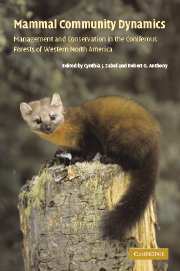 Mammal Community Dynamics
Mammal Community Dynamics Book contents
- Frontmatter
- Contents
- List of contributors
- Foreword
- Acknowledgments
- Part I Management and conservation issues for various taxa
- Part II Community and ecosystem relations
- Part III Conservation issues and strategies
- 16 Small mammals in a landscape mosaic: implications for conservation
- 17 Measuring and interpreting connectivity for mammals in coniferous forests
- 18 An evolutionary and behavioral perspective on dispersal and colonization of mammals in fragmented landscapes
- 19 The functional diversity of mammals in coniferous forests of western North America
- 20 Synopsis and future perspective
- Index
- References
18 - An evolutionary and behavioral perspective on dispersal and colonization of mammals in fragmented landscapes
Published online by Cambridge University Press: 15 December 2009
- Frontmatter
- Contents
- List of contributors
- Foreword
- Acknowledgments
- Part I Management and conservation issues for various taxa
- Part II Community and ecosystem relations
- Part III Conservation issues and strategies
- 16 Small mammals in a landscape mosaic: implications for conservation
- 17 Measuring and interpreting connectivity for mammals in coniferous forests
- 18 An evolutionary and behavioral perspective on dispersal and colonization of mammals in fragmented landscapes
- 19 The functional diversity of mammals in coniferous forests of western North America
- 20 Synopsis and future perspective
- Index
- References
Summary
Introduction
Animals are not distributed randomly in time or space; rather their dispersion, movement, and distribution are strongly dictated by their evolutionary history and social organization. Some animals are relatively solitary or territorial, occupy specific microhabitats, and exhibit limited movement, whereas others are gregarious and not territorial, form herds, and migrate over large expanses of heterogeneous habitat. Similarly, not all animals respond the same way to habitat mosaics, habitat fragmentation, movement barriers, and human disturbance. Many of our predictions of how habitat loss and fragmentation affect native populations is through retrospection, speculation, or modeling, rather than by a priori predictions of how particular populations or species will respond to habitat perturbations. Our lack of understanding of how species respond to habitat alterations is such that species often are treated as mathematical entities (i.e., all individuals are “average”) and individual-, sex-, and species-specific differences in response to fragmentation are not considered (Andrén 1994, Lima and Zollner 1996). Thus, animals are not always distributed as predicted by spatially explicit models, GAP analysis, habitat suitability indices, and so forth (Boone and Krohn 2000).
Some of the observed versus predicted differences in distribution of species across landscapes or in response to fragmentation can be explained by differences in their evolutionary history, dispersal ability, and social organization (Wolff 1999). In this chapter I use evolutionary and behavioral theory to predict some of the demographic consequences of habitat alteration for populations of mammals distributed in continuous and fragmented forest landscapes.
- Type
- Chapter
- Information
- Mammal Community DynamicsManagement and Conservation in the Coniferous Forests of Western North America, pp. 614 - 630Publisher: Cambridge University PressPrint publication year: 2003
References
- 3
- Cited by


